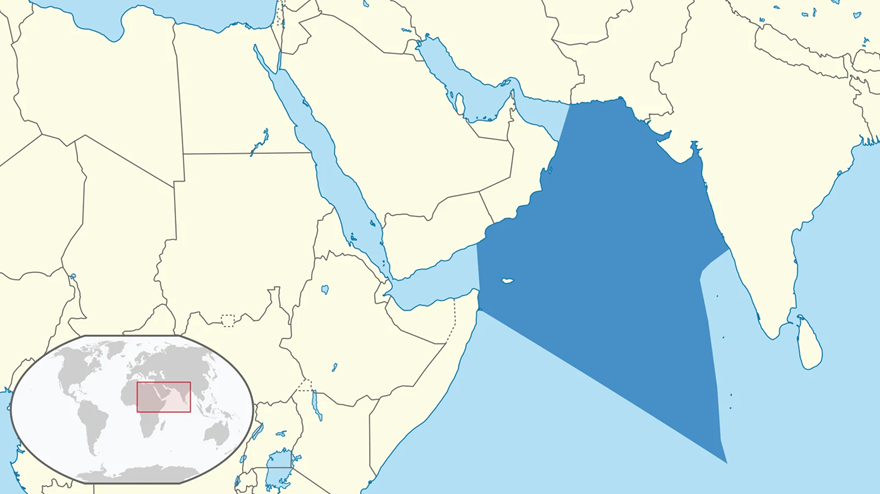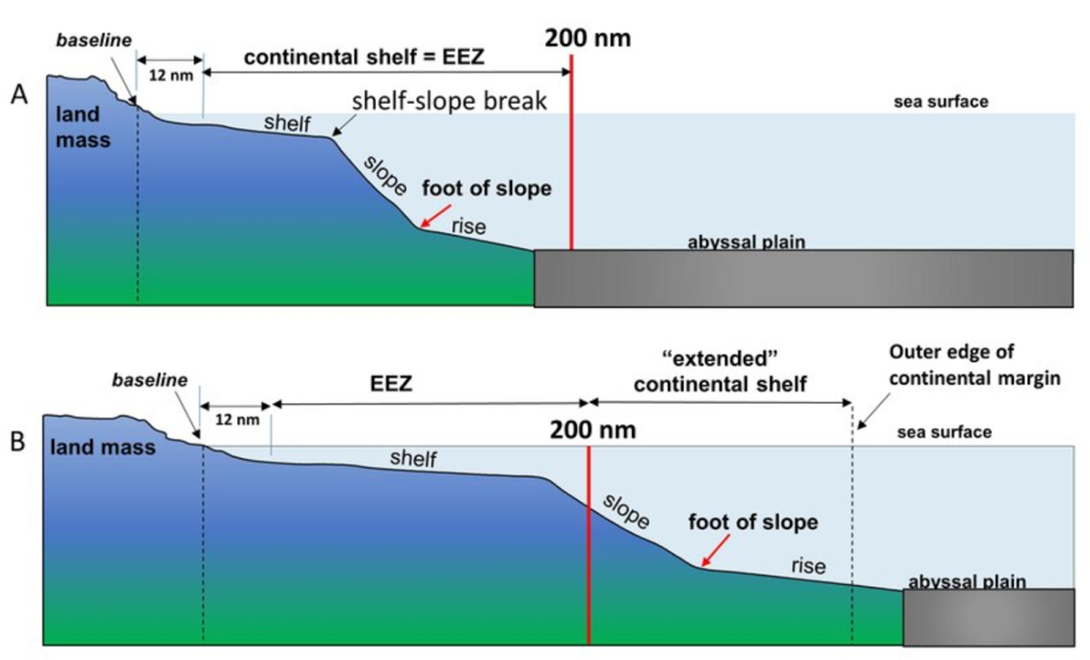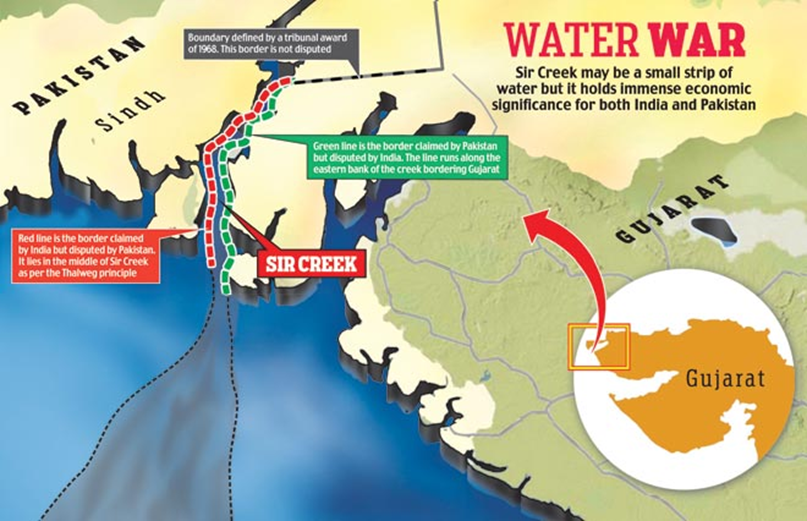- In April 2025, India submitted a revised claim for an Extended Continental Shelf (ECS) in the Central Arabian Sea.
- The new claim adds approximately 10,000 square kilometers of seabed to India’s maritime territory.
- India excluded the disputed Sir Creek region, which lies in the Western Arabian Sea, from this submission.
- This exclusion was done to avoid the maritime boundary dispute with Pakistan.
- The revised claim was submitted to the United Nations Commission on the Limits of the Continental Shelf (CLCS).

Key Maritime Zones Under UNCLOS

- Territorial Sea
- It extends up to 12 nautical miles from a country’s baseline (coastline).
- The country has full sovereignty over this area, similar to its land territory.
- Exclusive Economic Zone (EEZ)
- It extends up to 200 nautical miles from the coastline.
- The country has exclusive rights to explore and exploit marine resources like fish, oil, gas, and minerals in this zone.
- Extended Continental Shelf (ECS)
- It lies beyond the 200 nautical mile EEZ.
- A country can claim this area if it provides scientific proof that the seabed is a natural extension of its continental landmass.
- Only seabed and subsoil rights are granted, not the water above.
Commission on the Limits of the Continental Shelf (CLCS)
- The CLCS was established in 1997 under the United Nations Convention on the Law of the Sea (UNCLOS).
- It is responsible for evaluating ECS claims submitted by coastal states.
- It consists of 21 experts in geology, geophysics, hydrography, and related fields.
- CLCS recommendations are based on scientific evidence and are legally binding.
India’s ECS Claim Timeline and Background
- 2009: First Submission by India
- India submitted its 1st ECS claim to the CLCS in 2009.
- The claim covered 3 regions: the Bay of Bengal, the Indian Ocean, and the Arabian Sea.
- India claimed about 1.2 million square kilometers of seabed beyond its EEZ.
- The claim was based on scientific data showing that the seabed extended naturally from India’s landmass.
- 2021: Pakistan’s Objection
- In 2021, Pakistan raised objections to India’s claim, particularly in the Western Arabian Sea.
- Pakistan objected to the inclusion of the Sir Creek region, which is a disputed waterway between India and Pakistan.

- 2023: Rejection by CLCS
- In March 2023, the CLCS rejected India’s entire claim in the Arabian Sea region.
- The rejection was not limited to the Sir Creek area but applied to the full Arabian Sea portion of the claim.
- The dispute with Pakistan over Sir Creek was one of the key reasons for the rejection.
- CLCS allowed India to resubmit a modified claim that addressed these concerns.
India’s Revised ECS Submission – April 2025
- India again submitted a modified ECS claim to the CLCS in April 2025.
- The revised claim focused only on the Central Arabian Sea.
- This area is not affected by any maritime dispute with neighboring countries.
- India claimed an additional 10,000 square kilometers in this region.
- This claim is based on fresh scientific data showing the seabed is a natural extension of the Indian continental shelf.
- India excluded the Western Arabian Sea and Sir Creek region from the revised submission.
- By doing so, India avoided international conflict and increased the chances of CLCS approval.
Why did India Exclude Sir Creek?
- Sir Creek is a 96-kilometer-long tidal estuary located between Gujarat (India) and Sindh (Pakistan).
- It opens into the Arabian Sea and plays a crucial role in determining maritime boundaries.
- The dispute arises from different interpretations of how the maritime boundary should be drawn.
- India wants the boundary based on the Thalweg principle, which places the boundary in the middle of the navigable channel.
- Pakistan argues that Sir Creek is not navigable, so the Thalweg principle should not apply.
- Due to this unresolved issue, including Sir Creek in the ECS claim risked rejection of the entire submission.
- India therefore excluded this region in 2025 to focus on securing uncontested seabed territory first.
Strategic Importance of India’s Revised Claim
- If accepted, the ECS claim will give India the right to explore and extract valuable resources from the seabed.
- These include oil, natural gas, and deep-sea minerals such as polymetallic nodules.
- This supports India’s long-term energy security and economic growth.
- By excluding the Sir Creek area, India avoids direct confrontation with Pakistan in international forums.
- This increases the likelihood of approval from CLCS and helps maintain diplomatic stability.
- India’s strategy is to secure undisputed ECS zones like the Central Arabian Sea before resolving contentious ones.
- This allows India to claim seabed rights incrementally and with stronger international support.
Regional and Global Dimensions
- India and Oman have overlapping ECS zones in parts of the Arabian Sea.
- However, both countries agreed in 2010 not to dispute these overlapping areas.
- This mutual understanding has helped avoid conflict and build maritime cooperation.
- India’s ECS claims in the Bay of Bengal and the Indian Ocean are still under review by the CLCS.
- These claims are facing objections from Myanmar and Sri Lanka.
- The CLCS is expected to begin consultations for these regions in the coming months.
Conclusion
India’s revised ECS claim in the Central Arabian Sea reflects a carefully calculated diplomatic and scientific strategy. By removing the disputed Sir Creek region from the claim, India has prioritized securing uncontested maritime rights. This move protects India’s long-term economic interests while reducing the risk of international conflict. It also demonstrates India’s commitment to international law and peaceful resolution of maritime disputes.




